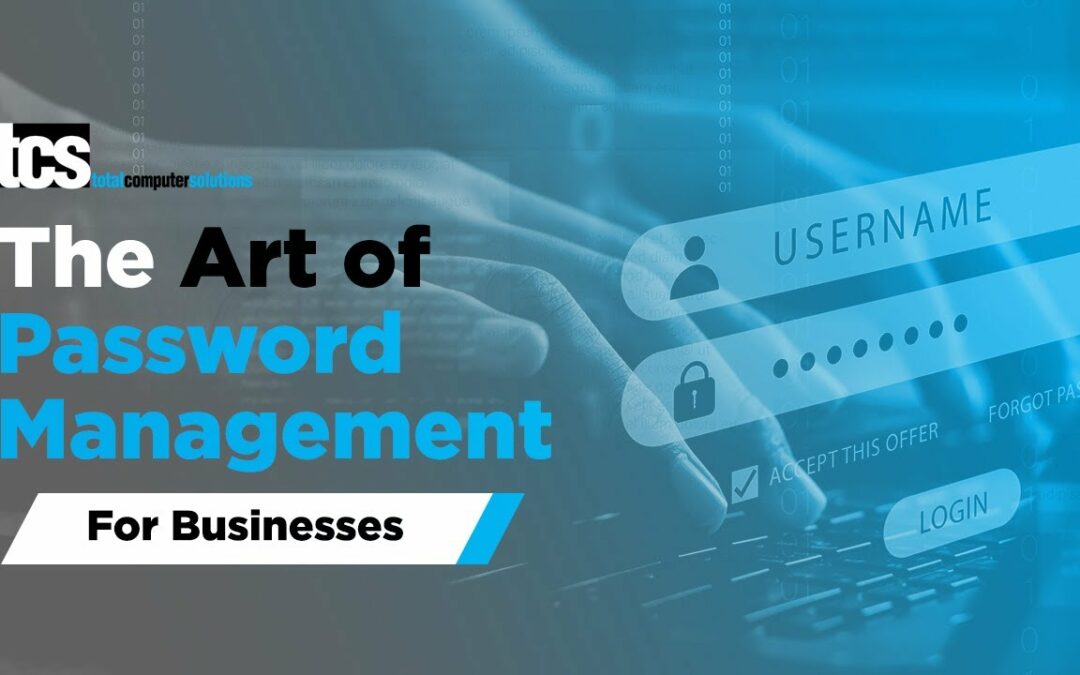Cyber threats are constantly rising; protecting sensitive data is a top priority for all businesses and individuals. Creating strong passwords is one of the most basic yet crucial aspects of cybersecurity. We use passwords daily to access various online platforms, from banking websites to social media accounts. However, it’s essential to recognize that the days of simple, easily guessable passwords are long gone. Below, we take on password management for businesses and provide valuable insights on creating strong and secure passwords to safeguard your business against malicious attacks.
The Importance of Strong Passwords
With data breaches and ransomware attacks constantly making headlines, the need for solid password management for businesses has never been more critical. Passwords serve as the first defense against unauthorized access to sensitive information. They act as digital locks, protecting our personal and business data from falling into the wrong hands.
However, despite their ubiquity in our daily lives, password management for businesses is often taken for granted. Many still use weak or easily guessable passwords, leaving themselves vulnerable to cyberattacks. It’s crucial to understand that creating a strong password is no longer just a recommendation; it’s a necessity.
Don’t overlook some of the below common questions about passwords. We’ll provide practical tips on creating robust passwords to secure your business and protect your valuable data.
Length Matters
One of the most critical factors when creating strong passwords is length. In the past, passwords of 6-10 characters were considered acceptable. However, advancements in computing power and password-cracking techniques have rendered these shorter passwords ineffective at keeping hackers at bay. We recommend a password of 16 characters, for example.
Why Longer Passwords Are Better
To illustrate the importance of password length, let’s explore how quickly modern computers can crack different password lengths. Suppose you have an 8-character password comprising both uppercase and lowercase letters. With today’s technology, a specially built software tool can crack this password in as little as 2 minutes by trying hundreds of thousands of options every second.
However, if you increase the password length to 16 characters, the estimated time to crack it skyrockets to a staggering 24 years. The exponential increase in cracking time demonstrates the importance of making your passwords longer.

Tips for Creating Long Passwords
Now that we understand the significance of length, let’s explore some tips for creating long passwords:
1. Combine Different Character Types: Incorporate a mix of uppercase letters, lowercase letters, numbers, and special characters (e.g., @, #, $, %) into your password. This adds a layer of complexity that makes it harder for hackers to crack.
2. Avoid Common Phrases or Dictionary Words: Using easily guessable phrases or dictionary words as passwords significantly weaken their security. Hackers can employ sophisticated algorithms that systematically test known phrases or common words.
3. Use Acronyms or Abbreviations: Consider creating passwords using acronyms or abbreviations that are memorable to you but difficult for others to guess. For example, “ILikeToEatPizza” could be transformed into “IL2EP.”
4. Utilize Random Characters: Introduce random characters throughout your password, making it even more unpredictable. Replace certain letters with similar-looking numbers or symbols. For instance, “Passw0rd!” is a stronger variation of the word “Password.”
Remember, the goal is to create a lengthy and complex password that is easy for you to remember but hard for others to crack. By incorporating these tips into your password management for businesses, you’ll significantly enhance the strength of your online security.
The Power of Special Characters in Password Management for Businesses
Special characters play a vital role in strengthening passwords by adding an extra layer of complexity. These characters include symbols such as @, !, #, $, %, and many others. While not mandatory in all cases, including special characters in your password can significantly enhance its security.
Adding Complexity with Special Characters
Including special characters in your password enhances its strength in several ways. Special characters are not as commonly used or predictable as letters and numbers, making them harder for hackers to crack. Additionally, they expand the pool of possible combinations, increasing the complexity and making brute-force attacks harder.
Best Practices for Special Characters in Password Management for Businesses
When using special characters in your passwords, consider the following best practices:
1. Don’t Just Append a Special Character: Avoid the temptation to merely add a special character at the beginning or end of your password. For example, “P@ssword123” is stronger than “Password!” since it incorporates a special character within the password.
2. Mix-Up Special Characters: Use various special characters throughout your password rather than repeating the same one. This adds another layer of complexity and unpredictability.
3. Don’t Rely Solely on Substitutions: While replacing certain letters with similar-looking symbols can increase password complexity, don’t solely rely on this technique. Hackers are familiar with common letter-to-symbol substitutions and will account for them in their cracking attempts.
By strategically utilizing special characters in your password management for businesses, you can significantly improve their strength and reduce the likelihood of unauthorized access.

Passphrases: The Future of Secure Authentication
In recent years, an alternative to traditional passwords has emerged: passphrases. A passphrase is like a password but typically longer and uses multiple words or phrases. Passphrases offer superior protection against hacking attempts and are easier to remember than complex passwords.
What Are Passphrases?
Passphrases are a different type of password management for businesses in that they consist of multiple words or phrases concatenated together. Unlike short passwords that are easily cracked through brute force or dictionary-based attacks, passphrases introduce complexity by lengthening the number of characters involved.
Advantages of Passphrases over Traditional Passwords
The use of passphrases offers several advantages over traditional passwords:
1. Length and Complexity: Passphrases are longer than typical passwords, making them more resistant to brute-force attacks. The increased length adds an extra layer of complexity, increasing the number of possible combinations.
2. Ease of Remembering: Due to their structure and use of familiar words or phrases, passphrases are generally easier to remember than complex passwords comprised of a random combination of characters.
3. Better Resilience to Dictionary Attacks: Since passphrases involve multiple words rather than single terms, they do not match dictionary words, making it difficult for attackers to crack them using conventional dictionary-based techniques.
Examples of Strong Passphrases
To demonstrate the effectiveness of passphrases as password management for businesses, let’s consider a few examples:
1. “Grimsley-whirlies-1990”
2. “Sunshine-butterflies-moonlight”
3. “Beach-sand-ocean-waves”
These examples highlight how combining seemingly unrelated words or phrases into a passphrase can create a robust defense against unauthorized access. With today’s technology, cracking a 28-character passphrase like “sunshinebutterfliesmoonlight” would take more than a hundred quintillion years – a virtually impossible task for hackers. Hence, this can be a wildly effective form of password management.
By leveraging passphrases, you can enhance the security of your business accounts and protect sensitive data from malicious actors.
Frequency of Password Changes
One long-standing debate in password management for businesses is whether regular password changes are necessary. Organizations have enforced policies requiring employees to change their passwords frequently for years. However, recent studies suggest this approach may not necessarily lead to more robust security.
Debunking the Myth of Frequent Password Changes
A study by The University of North Carolina revealed exciting findings regarding the frequency of password changes. Contrary to popular belief, frequently changing passwords does not continually improve security. The study concluded that frequent password changes can have unintended consequences.
A Case for Less Frequent Password Changes
The UNC study highlighted the following key points regarding password management for businesses:
1. User Behavior: When forced to change passwords frequently, users often write down their new passwords or use slight variations of previous passwords. This behavior weakens security and increases the risk of unauthorized access.
2. Password Complexity: Longer and more complex passwords or passphrases are generally more secure than shorter ones. By encouraging strong passwords instead of forcing frequent changes, organizations can prioritize user-friendly practices while maintaining robust security protocols.
3. Risk-Based Approach: Organizations should consider a risk-based model rather than adopting a one-size-fits-all approach to password changes. Regular password changes may still be warranted for high-risk accounts or situations where sensitive data is involved. However, less frequent changes may be acceptable for lower-risk scenarios, such as accessing internal systems without exposure to external threats.
Ultimately, organizations should evaluate their needs and balance the potential benefits of frequent password changes against the risks of increased human error and weaker overall password security.
The Dangers of Password Reuse
One common mistake many people make is reusing passwords across multiple platforms or accounts. While it may seem convenient, password reuse poses significant risks and should always be avoided.
The Risks of Reusing Passwords
The dangers of password reuse stem from the interconnected nature of online accounts. If an attacker gains access to one account due to a compromised password, they can easily test that same password across various platforms to gain unauthorized entry.
To illustrate this point, let’s consider a scenario where you reuse the same password for two banks. If one bank experiences a security breach, exposing your password, the attacker can access both banks instantly. They can compromise multiple accounts with minimal effort and potentially gain control over your financial assets or personal information.
Strategies for Avoiding Password Reuse
To minimize the risk of password reuse, consider implementing these strategies in your password management for businesses:
1. Unique Passwords: Always use a unique password for each online platform or account you access.
2. Password Manager: Utilize a password management tool to generate strong, random passwords for every site or service you use. These tools securely store and autofill your login credentials, removing the burden of remembering multiple passwords.
3. Educate Employees: If you manage an organization’s IT security, emphasize the importance of not reusing passwords during employee training sessions. Educate them about the risks involved and provide resources to help them adopt good password hygiene practices.
Adopting these strategies and avoiding password reuse reduces the chances of a single compromised password significantly, leading to widespread unauthorized access.
Enforcing Complex Passwords Across an Organization
In corporate settings, it is essential to enforce complex password policies to maintain high levels of cybersecurity across the entire organization. However, implementing practical password requirements can be challenging without proper planning and coordination.
Implementing Password Policies
If your company uses a Windows “domain,” you can enforce specific password standards for users accessing the domain. This capability allows administrators to define rules such as minimum length, complexity (e.g., requiring special characters), and expiration periods for user passwords.
When defining password policies, keep the following best practices in mind:
• Length Requirement: Set a minimum password length that meets industry standards (e.g., at least 12 characters).
• Complexity Requirements: Mandate the inclusion of special characters, uppercase letters, lowercase letters, and numbers to create stronger and more resilient passwords.
• Expiration Periods: Consider setting a reasonable expiration period based on the level of sensitivity of the information accessed through the domain. For especially sensitive data, shorter expiration periods may be appropriate, while less sensitive systems could have longer intervals between password changes.
• Password History: Configure the system to remember several previous passwords, preventing users from reusing recently used passwords.
Educating Employees on Strong Password Practices
Enforcement is only effective when accompanied by education. Provide employees with training sessions or online resources emphasizing the importance of strong passwords and explaining best practices for creating secure login credentials.
Empower your staff by teaching them the following facts on password management for businesses:
1. The significance of unique and complex passwords
2. The dangers of password reuse
3. The role of passphrases in enhancing security
4. How to manage passwords effectively using password management tools
Organizations can ensure stronger cybersecurity throughout their infrastructure by integrating ongoing education and enforcing robust significantly .
Dual Factor Authorization: An Extra Layer of Security
To further enhance the security of business accounts, consider implementing dual-factor authorization (also known as two-factor authentication). Dual-factor authentication adds an extra layer of protection by requiring users to provide additional verification beyond their username and password.

How Does Dual Factor Authorization Work?
Dual-factor authorization is a form of password management for businesses that typically involves the following steps:
1. The user enters their username and password.
2. The system prompts the user to verify their identity through a second factor (e.g., a code sent to their mobile phone via SMS).
3. The user enters the secondary authentication code.
4. Access is granted if the code is valid; otherwise, the login attempt is rejected.
This additional step provides an extra assurance that even if someone obtains a user’s password, they will still need physical possession of the secondary authentication device (such as a smartphone) to gain access.
Benefits of Dual Factor Authorization
Implementing dual-factor authorization offers several benefits:
1. Enhanced Security: With dual factor enabled, unauthorized individuals would require the user’s password and physical access to their authentication device to gain entry.
2. Protection Against Credential Theft: Even if a hacker obtains a user’s password, they still need access to the second-factor authentication method (e.g., mobile phone) to log in successfully.
3. Reduced Risk of Phishing Attacks: Dual-factor authorization can thwart phishing attempts by requiring users to physically confirm their identity, even if their passwords are compromised.
For optimal security, consider enabling dual-factor authentication for critical accounts or situations involving sensitive data.
The Role of Password Management Tools
Managing several complex passwords across various platforms can be challenging for individuals and businesses. Password management tools provide an efficient solution by securely storing login credentials and automating the process.
Advantages of Using Password Management Tools
Using a tool for your password management for businesses can give several advantages:
1. Increased Convenience: With a password manager, you only need to remember one master password to unlock the vault containing all your other passwords.
2. Enhanced Security: Password managers generate unique, strong, and random passwords for each site or service you use, reducing the risk of weak passwords or password reuse.
3. Secure Storage: Password management tools store your encrypted passwords locally or in the cloud, protecting them from unauthorized access.
4. Auto-Fill Functionality: These tools streamline the login process by automatically populating username and password fields on websites and applications.
When choosing a password management solution, consider compatibility with different devices and operating systems, encryption strength, user-friendly interface, and customer support options.
If you’re not sure, tap in the experts at TCS for more about password management for businesses, managed IT services, and how to protect your business.
Protecting Your Business with Strong Passwords
Obviously, creating strong passwords is essential in today’s digital landscape. Luckily, you can significantly enhance your business’s cybersecurity posture by following best practices like using longer passwords, incorporating special characters, leveraging passphrases, and avoiding common pitfalls like password reuse.
Additionally, enforcing robust password policies, educating employees, implementing dual-factor authorization, and leveraging password management tools are critical steps to protect sensitive data from unauthorized access.
Remember the key takeaways:
• Opt for longer passwords of at least 16 characters or more.
• Use a combination of uppercase and lowercase letters, numbers, and special characters for added complexity.
• Consider passphrases as an alternative to traditional passwords.
• Rethink the necessity of frequent password changes; prioritize strong passwords over unnecessary frequency.
• Avoid reusing passwords across different platforms to minimize the risk of account compromise.
• Enforce complex password policies throughout your organization while providing comprehensive employee training.
• Implement dual factor authorization for an additional layer of protection.
• Leverage password management tools to streamline password creation, storage, and autofill processes.
By incorporating these practices into your business’s security protocols, you can safeguard valuable data and reduce the risk of falling victim to cyber threats. Stay vigilant, stay secure, and enjoy peace of mind, knowing that strong password management for businesses like yours can keep you protected.
If you’re interested in how TCS can help you keep your business protected or your employees trained on best practces, reach out to us today. We can create a more secure network for your company.





